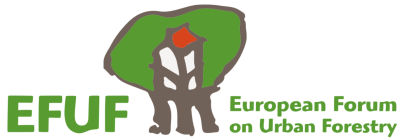This post has been written by Itziar Aguinaga Gil and was orginally published at EFI’s Resilience Blog.
Every couple of years, the Food and Agriculture Organization of the United Nations(FAO) publishes a series of reports under the name of The State of the World’s Forests (SOFO). These documents compile current information on key issues concerning the forest sector to facilitate decision-making and management processes in relation to the world’s forests.
The last SOFO, published in 2018, for the first time ever discusses the role of urban forests under the framework of the Sustainable Development Goals (SDG). In response to the accelerated urbanisation coupled with climate change dynamics, urban forests are viewed as a valuable contribution to “make cities and human settlements inclusive, safe, resilient and sustainable” (SDG 11). Both in theory and practice, urban forests and trees have a positive impact on urban environmental conditions and citizens´ livelihoods and well-being.
The potential value of urban forests for urban areas depends on whether their management is integrated in the urban planning dynamics early on. An early integration allows an equitable distribution of green areas across the urban landscape and enhances the resilience of the city on the long run. As such, the city should invest in financial resources to provide the proper implementation of urban forestry projects and its monitoring over time.
Several tools have been developed to quantify the environmental and sociocultural benefits of urban forests and trees. For instance, i-Tree Eco, a software developed by the US Forest Service, is considered one of the most promising tools to assess both the composition and ecosystem services provided by urban forests and trees in monetary terms. Thanks to this tool, it has been estimated that the annual pollution removal effect of urban trees in London is worth 126 million GBP (Rogers et al., 2015).
Another tool to evaluate the benefits of urban forests is to assess the tree cover of cultural heritage sites that include natural elements. In fact, many cultural sites (which also embrace UNESCO World Heritage Sites) tend to have a high percentage of forest and tree cover that is highly valued by its visitors. This aesthetic benefit can greatly contribute to the sense of identity and attachment of urban dwellers by creating positive connections with local landmarks.
Urban forests and trees are also considered as an important factor enhancing local biodiversity. They provide habitats for numerous species and provide natural networks within the fragmented urban landscape. The importance of restoring local biodiversity through urban greening is evident in the light of the increase of urban natural protected areas during the last 15 years in countries like Germany, South Korea and Brazil (WDPA, 2017). Such areas do not only provide cities with ecosystem services, but also allow citizens to connect with natural habitats. Human-nature connections weaken over time in urban settings, and thus, urban natural protected areas help to “provide universal access to safe, inclusive and accessible green and public spaces” (SDG 11.7).
In addition, together with cultural heritage sites, natural protected areas and safe and accessible green spaces such as urban forests contribute to the sense of belonging and identification of local communities. This may translate, among others, into improved well-being of citizens through enhancing recreational actives and aesthetic values.
In a nutshell, urban citizens have more demands, but cities’ capacities are declining, so local surroundings need to improve through adequate urban planning. When positively integrated and monitored, urban forests can contribute to the sustainable development of cities by upgrading the livelihoods and well-being of urban dwellers. The benefits come both in the form of additional ecosystem services and improved socio-cultural factors.
There are many success stories around the world involving forests and cities, yet there may be more win-win solutions to come!
Would you like to learn more on how urban forests contribute to liveable cities? Check out the latest news through the European Forum on Urban Forestry 2019 at http://2019.efuf.org.
For further reading: check out guidelines on urban forestry and inspiring stories around the world.
